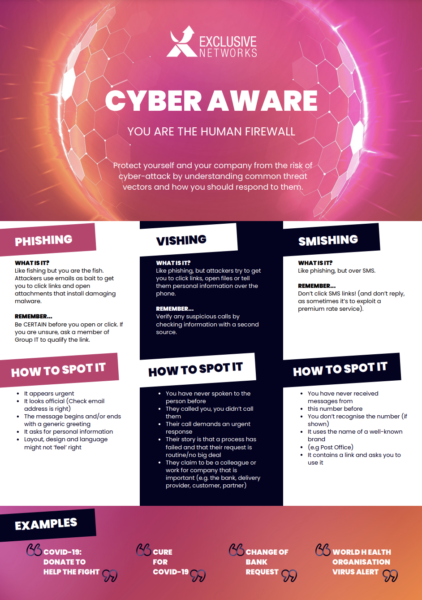The People Problem
People: They’re your biggest risk & first line of defence
Sign up to the Dedicated Cybersecurity Programme
They’re sat next to you in the office, they’re on your conference calls, and they’re helping to drive your business to growth: Your people!!
They’re your biggest risk….
The human psyche makes us vulnerable to manipulation, meaning your people pose an enormous cybersecurity risk to your business.
Cyber criminals target people in order to exploit them for their own gain.
Learn more about the threats to your organisation.
….and first line of defence
Whilst people may be a risk factor, this risk can be reduced if your security strategy includes a continual programme of cybersecurity awareness and training.
Learn more about cyber awareness and access assets you can use within your own business.
Cybersecurity Awareness & Training
Be Aware…..Be Very AWARE!!!
Last year alone, 82% of data breaches involved a human element1! That is why cybersecurity awareness MUST be a key element of a business’s cybersecurity strategy.
The consequences of not educating employees can be grave, with the average cost of a data breach standing at $4,24m in 20212. Companies simply cannot afford to neglect the need to continually educate their employees on the threats they face, and what they can do to reduce the risk that they – along with the business – become victim to cybercrime.
Whilst October is officially designated Cybersecurity Awareness Month, awareness must be an everyday topic for businesses and their employees. That is why Exclusive have created a helpful infographic for businesses to download and ‘plaster’ across their offices. Not only that, but it is available to dual-brand with your own logo.
Knowledge is power: Exclusive Training
Exclusive Networks are highly regarded as a training centre of excellence. Our technology manufacturers trust in our expert trainers to deliver their training and certifications around the world.
From a basic cybersecurity awareness training through to highly technical certifications, businesses can take advantage of our training services to develop a greater understanding of the cybersecurity threat landscape.
Interested to learn more?? Simply complete the short form below and our team will be in touch.





